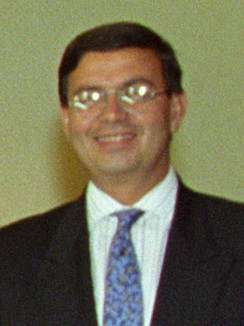Rafael Leonardo Callejas Romero facts for kids
Quick facts for kids
Rafael Callejas
|
|
|---|---|
 |
|
| 31st President of Honduras | |
| In office 27 January 1990 – 27 January 1994 |
|
| Vice President | Jacobo Hernández Cruz |
| Preceded by | José Azcona del Hoyo |
| Succeeded by | Carlos Roberto Reina |
| Personal details | |
| Born |
Rafael Leonardo Callejas Romero
14 November 1943 Tegucigalpa, Honduras |
| Died | 4 April 2020 (aged 76) Atlanta, Georgia, U.S. |
| Political party | National Party of Honduras |
| Spouse | Norma Gaborit |
| Alma mater | Mississippi State University |
| Profession | Businessman, politician |
Rafael Leonardo Callejas Romero (born November 14, 1943 – died April 4, 2020) was a very important leader in Honduras. He served as the President of Honduras from 1990 to 1994. He was a member of the National Party of Honduras, one of the country's main political groups.
Contents
Early Life and Education
Rafael Callejas was born in Tegucigalpa, the capital city of Honduras, on November 14, 1943. He moved to the United States for his university studies. He went to Mississippi State University. There, he studied how to manage farms and money, which is called agricultural economics.
He earned two degrees from the university. He got his first degree in 1965 and a higher degree in 1966. In 1966, he also wrote a special study about pig farming. Later, in 1990, his university honored him as a top former student. They even invited him to give a speech at their graduation ceremony.
Political Career
After finishing his studies, Callejas returned to Honduras. From 1967 to 1971, he worked for a group that planned the country's economy. In 1968, he became the leader of economic planning under President Oswaldo López Arellano.
Later, in 1975, another president, Juan Alberto Melgar Castro, made Callejas the person in charge of farming and natural resources. He kept this job even when Policarpo Paz García became president in 1978.
As Honduras moved towards becoming a democracy, Callejas became more important in the National Party of Honduras. In 1982, he led their main committee. He wanted his party to be more modern and focus on a free economy.
In 1985, Callejas ran for president. He got the most votes of any single candidate. However, the other main party, the Liberal Party of Honduras, had more total votes when all their candidates were added up. So, José Azcona del Hoyo from the Liberal Party became president instead.
Football Leadership
Besides his political work, Rafael Callejas was also involved in football (soccer). Until 2015, he was the President of the National Autonomous Federation of Football of Honduras (FENAFUTH). This is the main organization for football in Honduras.
Under his leadership, the Honduran national team achieved great success. They qualified for the FIFA World Cup in 2010 and 2014. This was the first time Honduras made it to two World Cups in a row. The country's teams also qualified for other major football events, including the Summer Olympic Games.
President of Honduras (1990-1994)
Rafael Callejas ran for president again in 1989. This time, he won with 52.3% of the votes. His election was a big moment for Honduras. It was the first time since 1932 that power was peacefully given from one major political party to the other.
When he became president, Honduras faced serious economic problems. Callejas followed advice from international financial groups. He cut government spending, which meant some public workers lost their jobs. He also changed the value of the Honduran currency, the Honduran lempira. This caused difficulties for many people.
At the start of his presidency, there was also a shortage of gasoline. Cars had to wait in long lines to get fuel. This led to many protests. However, his government successfully worked with the United States to reduce a large debt of $430 million in 1991.
His government worked to open up the Honduran economy. They encouraged local and foreign businesses to invest in the country. This helped the economy grow steadily during his last three years in office. He also focused on building better roads, especially in the rich Sula Valley area.
Callejas's government also made important improvements in social areas. They created programs like the Family Assistance Program (PRAF) and the Honduran Fund for Social Investment (FHIS). These programs aimed to help families and improve social conditions. Also, people who had left Honduras because of earlier military or liberal governments were allowed to return safely. The foreign armed groups, known as the Contras, were also required to leave Honduras in 1990 after talks.
Later Life and Passing
After his time as president, Rafael Callejas faced some legal challenges. In 2005, a law that gave former presidents special legal protection was removed. Mr. Callejas chose to go to court to face the accusations against him. He was found not guilty by the Honduran court for those charges.
Later, in 2015, he was involved in a case related to football. He traveled to the United States to cooperate with the authorities. In 2016, he admitted to accepting money in connection with football deals. Because of this, the international football organization, FIFA, banned him from football for life.
Rafael Callejas passed away on April 4, 2020, due to a serious illness called leukemia.
See also
 In Spanish: Rafael Leonardo Callejas para niños
In Spanish: Rafael Leonardo Callejas para niños

